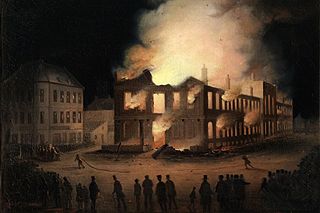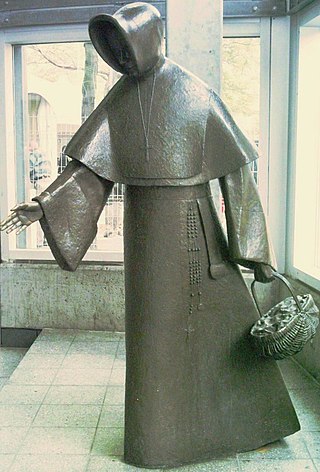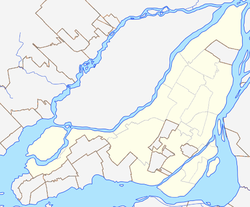History
It was near to this spot, previously crossed by the Saint-Pierre river, that the first European inhabitants of Montreal arrived in 1642. Soon after, this frequently flooded area was abandoned in favour of the hill overlooking rue Notre-Dame.
For many years, the land around the present-day square was owned by the Old Montreal General Hospital. That hospital for the poor, built between 1692 et 1694, was run at first by the Charon Brothers then, from 1747, by the Congregation of the Sisters of Charity of Montreal, or Grey Nuns, founded by Marie-Marguerite d'Youville.
Proximity to the port gave the area a new lease of life. In 1833, the marché Sainte-Anne was built to accommodate the fruit and vegetable sellers. The Georgian building consisted of two long wings, a Portico entrance on one end and a central section topped with a smaller steeple. The marché Sainte-Anne was so attractive that the Parliament of the Province of Canada moved into it in 1844, where the representatives of Upper and Lower Canada sat (present-day south Ontario and Quebec); a second market building built in 1844 behind the new Parliament building (and later demolished in 1860) substituted the original role of the old market. It was burned down on April 25, 1849, when English-speaking demonstrators drove the representatives out and set fire to the building because they opposed the Rebellion Losses Bill, pardoning those who had been involved in the Lower Canada Rebellion. Montreal thus lost its status as capital city.
After being rebuilt in 1852, the new building was once again a public marketplace, with a fish market added later. In 1871, the Grey Nuns left for a new home on René Lévesque Boulevard, then in the countryside. The opening up of rue Saint-Pierre towards the port involved the demolition of their former chapel; only the walls and the remains of old windows are left. Other buildings met the same fate in order to create space for rue Normand. In 1901, the demolition of the St. Anne's Market and the fish market cleared out the heart of the neighbourhood, and shops, public buildings and organizational headquarters moved in. It was at that time that the City of Montreal decided to name the area "place d'Youville", after Marie-Marguerite d'Youville, one of its first residents.

Verdun is a borough (arrondissement) of the city of Montreal, Quebec, located in the southeastern part of the island.

The Sisters of Charity of Montreal, formerly called The Sisters of Charity of the Hôpital Général of Montreal and more commonly known as the Grey Nuns of Montreal, is a Canadian religious institute of Roman Catholic religious sisters, founded in 1737 by Marguerite d'Youville, a young widow.

Ville-Marie is the name of a borough (arrondissement) in the centre of Montreal, Quebec. The borough is named after Fort Ville-Marie, the French settlement that would later become Montreal, which was located within the present-day borough. Old Montreal is a National Historic Site of Canada.

Mercier–Hochelaga-Maisonneuve is a borough of Montreal, Quebec, Canada located in the southeastern end of the island.

Le Sud-Ouest is a borough (arrondissement) of the city of Montreal, Quebec, Canada.

Old Montreal is a historic neighbourhood within the municipality of Montreal in the province of Quebec, Canada. Home to the Old Port of Montreal, the neighbourhood is bordered on the west by McGill Street, on the north by Ruelle des Fortifications, on the east by rue Saint-André, and on the south by the Saint Lawrence River. Following recent amendments, the neighbourhood has expanded to include the Rue des Soeurs Grises in the west, Saint Antoine Street in the north, and Saint Hubert Street in the east.

Bonsecours Market at 350 Saint-Paul street in Old Montreal, is a two-story domed public market located in Montreal, Quebec, Canada. For more than 100 years, it was the main public market in the Montreal area. It also briefly accommodated the Parliament of United Canada for one session in 1849.
The Legislative Assembly of the Province of Canada was the lower house of the Parliament of the Province of Canada. The Province of Canada consisted of the former province of Lower Canada, then known as Canada East, and Upper Canada, then known as Canada West. It was created by The Union Act, 1840.

Pointe-à-Callière Museum is a museum of archaeology and history in Old Montreal, Quebec, Canada. It was founded in 1992 as part of celebrations to mark Montreal's 350th birthday. The museum has collections of artifacts from the First Nations of the Montreal region that illustrate how various cultures coexisted and interacted, and how the French and British empires influenced the history of this territory over the years. The site of Pointe-à-Callière has been included in Montreal’s Birthplace National Historic Site since its designation in 1924.

Marguerite d'Youville, SGM was a French Canadian widow who founded the Order of Sisters of Charity of Montreal, commonly known as the "Grey Nuns". She was canonized by Pope John Paul II in 1990, becoming the first native-born Canadian to be declared a saint.

Place Émilie-Gamelin is a city square in central Montreal, Quebec, Canada. It was created to mark the 350th anniversary of the city. Bordered by Berri Street, Saint Hubert Street, Sainte Catherine Street, and De Maisonneuve Boulevard, the square is adjacent to the entrances of transportation hubs Berri-UQAM Metro Station and the former Station centrale d'autobus, as well as the Université du Québec à Montréal and the Grande Bibliothèque du Québec.

The Centre-Sud is a neighbourhood located in the easternmost edge of the Ville-Marie borough of the city of Montreal.

The burning of the Parliament Buildings in Montreal was an important event in pre-Confederation Canadian history and occurred on the night of April 25, 1849, in Montreal, the then-capital of the Province of Canada. It is considered a crucial moment in the development of the Canadian democratic tradition, largely as a consequence of how the matter was dealt with by then co-prime ministers of the united Province of Canada, Sir Louis-Hippolyte Lafontaine and Robert Baldwin.
The timeline of Montreal history is a chronology of significant events in the history of Montreal, Canada's second-most populated city, with about 3.5 million residents in 2018, and the fourth-largest French-speaking city in the world.

Émilie Tavernier Gamelin was a Canadian social worker and Roman Catholic religious sister. She is best known as the founder of the Sisters of Providence of Montreal. In 2001 she was beatified by Pope John Paul II.

The Grey Nuns' Hospital was a hospital in Montreal, Quebec, Canada that operated from 1695 to 1880. It is located south of Place d'Youville and west of Rue Saint-Pierre.

The Centre d'histoire de Montréal is a museum in Montreal, Quebec, Canada. It is located at 335 Place d'Youville in Old Montreal, in the borough of Ville-Marie. The museum is dedicated to the history of Montreal.

Place D’Youville, also referred to as carré D'Youville, is a public square in the core of Quebec City, Quebec, Canada. It is situated on rue Saint-Jean, one of the oldest roads in Quebec City. It marks the boundary between the Quebec Parliament Hill and Old Quebec. The square is named in honour of Marie-Marguerite d'Youville, a French Canadian widow who founded the religious order known as the Grey Nuns of Montreal.

St. Anne's Market was a public auction house located at Place d'Youville in Old Montreal. From 1844 to 1849, it served as the home of the Legislative Council and Assembly during the pre-Confederation era. On April 25, 1849, the building was burned down by Loyalist rioters.
Exo Sainte-Julie sector is the public transportation service for the small city of Sainte-Julie in southwestern Quebec, Canada. This municipality is located in the Marguerite-D'Youville Regional County Municipality, about 25 kilometres (16 mi), southeast of downtown Montreal.





















